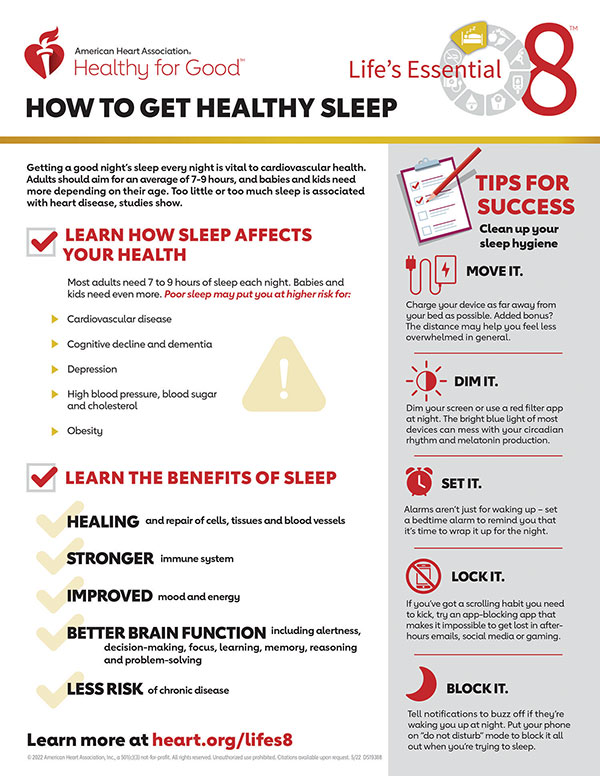6 Steps to Get Better Sleep and Improve Heart Health

(Family Features) There’s more to maintaining a healthy heart than just eating right and exercising regularly. While these practices play an important role in both cardiovascular and overall health and well-being, getting a good night’s sleep is also key.
“Getting a good night’s sleep every night is vital to cardiovascular health,” said Donald M. Lloyd-Jones, M.D., Sc.M., FAHA, past volunteer president of the American Heart Association and chair of the department of preventive medicine, the Eileen M. Foell Professor of Heart Research and professor of preventive medicine, medicine and pediatrics at Northwestern University’s Feinberg School of Medicine. “Adults should aim for an average of 7-9 hours, and babies and kids need more depending on their age.”
However, more than 1 in 3 adults in the United States are not getting the recommended 7-9 hours of sleep per night, according to the Centers for Disease Control and Prevention (CDC). In addition to increasing risk for cardiovascular conditions like high blood pressure, heart disease, heart attack and stroke, lack of sleep may also put people at risk of depression, cognitive decline, diabetes and obesity.
While high blood pressure – a known risk factor of cardiovascular disease, the No. 1 cause of death worldwide – can run in families, it is more common in non-Hispanic Black adults (56%) than in non-Hispanic white adults (48%), non-Hispanic Asian adults (46%) or Hispanic adults (39%). Healthy lifestyle behaviors, including sleep, can help prevent the condition.
“We know that people who get adequate sleep manage other health factors better as well, such as weight, blood sugar and blood pressure,” Lloyd-Jones said. “The American Heart Association added sleep to the list of factors that support optimal cardiovascular health. We call these Life’s Essential 8, and they include: eating a healthy diet, not smoking or vaping, being physically active and getting adequate sleep along with controlling your blood pressure and maintaining healthy levels of cholesterol and lipids, healthy blood sugar levels and a healthy weight.”
What’s more, falling asleep at different times or sleeping an inconsistent number of hours each night, even variations of more than two hours a night within the same week, may also increase the risk of atherosclerosis, which is a cardiovascular condition where plaque builds up in the arteries, in those age 45 and older, according to research published in the “Journal of the American Heart Association.”
“Maintaining regular sleep schedules and decreasing variability in sleep is an easily adjustable lifestyle behavior that can not only help improve sleep, but also help reduce cardiovascular risk for aging adults,” said study lead author Kelsie Full, Ph.D., M.P.H., an assistant professor of medicine in the division of epidemiology at Vanderbilt University Medical Center.
Education about healthy heart habits from the American Heart Association is nationally supported by Elevance Health Foundation. Some practices to improve sleep health and impact heart health include:
Observe Current Sleep Habits
 Keeping a sleep diary to help track your sleep patterns and habits can make it easier to identify factors that may be helping – or hurting – your sleep quality. Monitor what time you go to bed, what time you wake up in the morning, how many times you woke up during the night, how you felt when you woke up and any variables, such as changes to your routine or sleeping arrangements. Having documentation over the course of several weeks can help you identify necessary changes.
Keeping a sleep diary to help track your sleep patterns and habits can make it easier to identify factors that may be helping – or hurting – your sleep quality. Monitor what time you go to bed, what time you wake up in the morning, how many times you woke up during the night, how you felt when you woke up and any variables, such as changes to your routine or sleeping arrangements. Having documentation over the course of several weeks can help you identify necessary changes.
Avoid Food and Beverage Close to Bedtime
It can be more difficult to fall asleep if you’re still digesting dinner. To help reduce sleep disruptions caused by food, avoid late dinners and minimize fatty and spicy foods. Similarly, keep an eye on caffeine intake and avoid it later in the day when it can be a barrier to falling asleep.
Exercise Regularly
Physical activity during the day can have a noticeable impact on overall health and wellness but can also make it easier to sleep at night as it can initiate changes in energy use and body temperature. However, exercising too close to bedtime may hinder your body’s ability to settle; aim to have your workout complete at least four hours before you plan to head to bed.
Establish a Bedtime Routine
Getting a good night’s rest often requires getting into a routine. Start by setting an alarm to indicate it’s time to start winding down. Rather than heading straight to bed, take time to create a to-do list for the following day and knock out a few small chores. Then consider implementing a calming activity like meditating, journaling or reading (not on a tablet or smartphone) before drifting off to sleep. Also set an alarm to wake each morning, even on weekends, and avoid hitting the snooze button to keep your biological rhythms synced.
Create a Comfortable Sleep Space
The ideal space for sleeping is dark, quiet and a comfortable temperature, typically around 65 F depending on the individual. Use room-darkening curtains or a sleep mask to block light and ear plugs, a fan or a white noise machine to help drown out distracting noises. Remember, using your bed only for sleep and sex can help establish a strong mental association between your bed and sleep.
Avoid Tech Before Bed
The bright light of televisions, computers and smartphones can mess with your Circadian rhythm and keep you alert when you should be winding down. Try logging off electronic devices at least one hour before bedtime and use the “do not disturb” function to avoid waking up to your phone throughout the night. Better yet, charge devices away from your bed or in another room entirely.
Find more tips to take control of your blood pressure and create healthy sleep habits at Heart.org.
Photo courtesy of Getty Images
SOURCE:
American Heart Association

